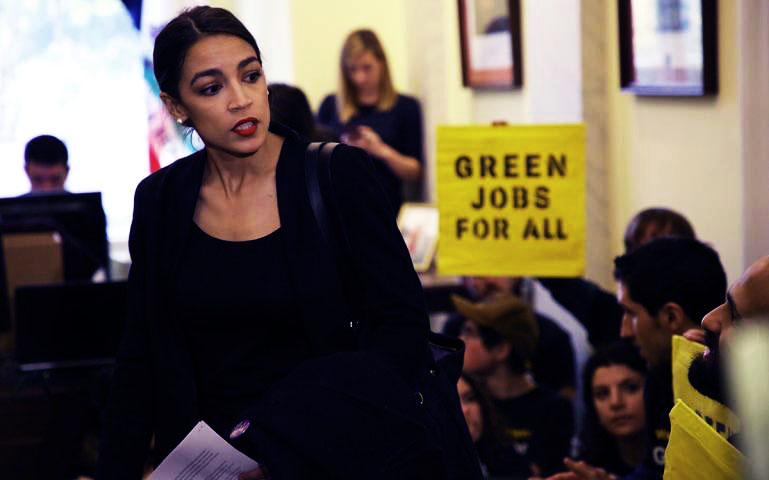Contributed by Joe Montero
A reader commented at some length on an article (The Green New Deal approach would be good for Australia as well as the United States), published in The Pen (13 February 2019).
It has fallen to me to answer. What is provided here, is not an exhaustive argument, since it only touches on the points that have been raised. The intention is to encourage further debate on this topic.
The article in question, written by Jim Hayes, concerns a positive take on the the concept of the Green New Deal raised by people like Alexandria Ocasio-Cortez in the United States and and its applicability to Australian conditions.

What our reader says, boils down to implying, that a Green New Deal will not work. He is wrong.
At the core of what our reader is saying is, that the function of taxation is to withdraw money from the economy and government spending is to introduce money into it.
Basically, this is true. Governments do use taxation to influence the quantity of money in the economy. At the same time, there is also much more to it.
The central characteristic of money is that it is a medium of exchange. To be this, it must be a commodity, an object that has an inherent value. This takes two forms. One is that it is a specific commodity that has its own intrinsic worth. For money, this is that it is a store of value. It can be put away and used at another time. The other is that it is an equivalent. That is, it has what can be called a use value, in that it can be exchanged for other commodities to satisfy perceived needs. Without these two characteristics, money cannot be a medium of exchange.
Money is therefore tightly bound with what is sometimes called the real economy, where goods and services are made and circulated. The implication of this, is that a given quantity of money is needed for an economy to function. If it deviates from this, there is an imbalance nd the connection between money and the real economy begins to unravel. Thus, governments intervene to correct this.
But governments are also players in other respects. They provide goods and services and are consumers. Taxation, therefore, does not only influence the quantity of money in an economy. It has an impact on what is produced and consumed in it. When governments come up with policies aimed at these influences, it is called fiscal policy. By not making the connection, our reader fails to see this vital link. I will come back to this.
First, let’s look at the assertion that “it is operationally impossible for taxation to fund Federal Government spending.” The argument rests on the notion that government spending adds to the financial assets of the private sector, while taxes take away from this. There is some truth to this. But once again, it is only part of the story.
As a producer and consumer, government can use taxation and the revenue that comes from it, to have an influence over how the money supply in an economy is used. To some extent, official interest rates can do this. But because they cannot deviate too far or for too long, from the underlying natural interest rate, this has its limit. Government taxation and expenditure can do more in this respect, and can serve to influence the future shape of the economy.
Taxation can also be used to redistribute money. For example, ensuring that major corporations actually pay the existing tax rate, would enable shifting this money to the rest of society. It can make a difference to individuals and it can discourage what society considers a harm and encourage something that society considers a benefit. For example, taxation can be used to discourage a carbon based economy and encourage green alternatives. It can be used to change spending habits and spread the cost of providing essential government services.
Our reader seems to regard money as static. Money can only realise its nature as a medium of exchange by being in circulation. This means that it must constantly be moving from one hand to another. The consequence is that, in addition to its quantity, the rate by which it moves is just as important
The rate of circulation of money has risen so much in the computer age, that it has become the bigger determinant of the rate of inflation. Controlling the quantity of currency is no longer as important as it was. Money now circulates at an incredible rate, and in huge quantities, by the touch of a computer key, rather than the physical movement of currency.
In comes the role of credit. Simply, this is borrowing money to consume now and paying for it later. It is one of the most popular personal finance choices when it comes to borrowing money. It is another way to increase the rate of circulation of money. A drawback of credit is that if it does not result in a sufficient increase in the stock of value, the means to pay for it later on is not realised. The consequences can be serious.
For an economy, increasing the quantity of money or the rate of its circulation within a sufficient increase in the stock of the total value, will result in an increase in prices. Taxation can be used as a means, although not the only one, to counter this.
The assertion that Australia is a spend and then tax economy is true. Governments must plan and spend at the point of application. Instead of coming in at the same time, most taxation comes in incrementally over the financial year, and this time gap between spending and receiving revenue is covered through borrowing, or in other words, government credit.
The same applies to the business sector. The difference is, and this is important, that the individual business must raise enough funds from its operations to cover cover the loan. Collectively, business must raise enough in total, and increase the total stock of value.
Governments cannot cover their debts by their own efforts, and must doso, by raising the revenues from society as a whole. This is best achieved through taxation.
We finish up by returning to the essential link between the quantity of money, the rate of its circulation, and the circulation of the stock of commodities in society. Without understanding these essential links, we know very little about the true nature of money, and by extension, the functions of taxation.



Be the first to comment on "A reply to a reader on the nature of taxation"